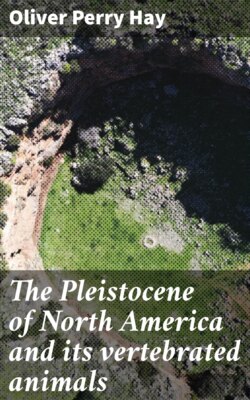Читать книгу The Pleistocene of North America and its vertebrated animals - Oliver Perry Hay - Страница 37
На сайте Литреса книга снята с продажи.
SOUTH CAROLINA.
ОглавлениеTable of Contents
17. Charleston.—In 1876 Leidy announced (Proc. Phila. Acad., 1876, p. 80) that a complete tusk of a walrus had been found in the Ashley River, near Charleston. This tusk Leidy described and figured in 1877 (Jour. Phila. Acad., vol. VIII, fig. 6). It had evidently been dredged from the river in collecting phosphate rock, as have been most of the fossils of that region. The tusk was 13 inches long. Near the base it measured 3.62 inches and transversely 1.75 inches. Leidy especially noticed the shortness of the tusk as compared with the diameter, but concluded that the tusk might, during the life of the individual, have been broken off and worn obliquely at the end.
In the collection of the Charleston Museum are some fragments of tusks of a species of walrus, probably O. rosmarus. One of these, No. 1028, furnishes 184 mm. of the distal end. The width at the fracture is 60 mm., the thickness 29 mm. The distal end is worn off somewhat obliquely, but not so much as in the tusk figured by Leidy; also, the tusk appears to have been less curved than the one which he described. The original length can not be determined.
Another fragment, No. 1029, was given to the Charleston Museum by Major E. Willis and was no doubt found in the region about Charleston. This gentleman has sent a fossil horse-tooth and a part of a sirenian to the U. S. National Museum from Wando River. The fragment is short, but belonged to a large tusk, its long diameter being 81 mm., the shorter one 51 mm. It was therefore a larger tusk and one whose thickness was relatively greater than that of the imperfect specimen found at Long Branch and figured by Leidy.
Mr. Earle Sloan’s collection at the Charleston Museum has two other fragments of tusks. One, No. 13497, is 113 mm. long, 60 mm. wide, and 25 mm. thick; the other, No. 13296, is 140 mm. long, 60 mm. wide, and 31 mm. thick.
Considering that all of the remains of the walrus found about Charleston have been picked out of great quantities of phosphate rock collected for commercial purposes, and that no records of the exact locality where obtained have been kept, it is impossible to determine their exact geological age. It is to be supposed that this animal inhabited the region about Charleston at the time it frequented the coasts of North Carolina and New Jersey. This appears to have been during the Wisconsin stage; but it is possible that the walrus extended its range far southward during more than one of the glacial stages. All of the specimens appear to be thoroughly fossilized.
